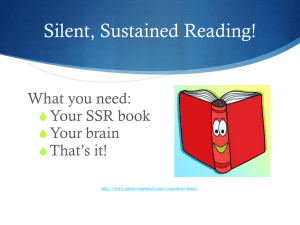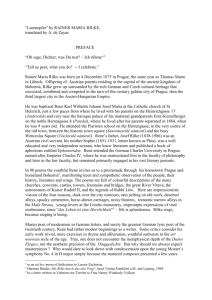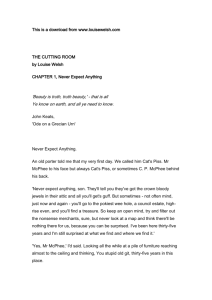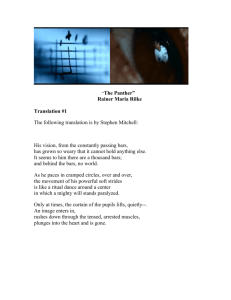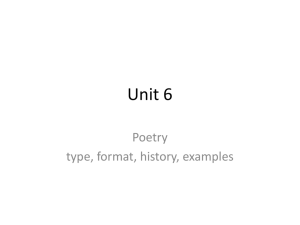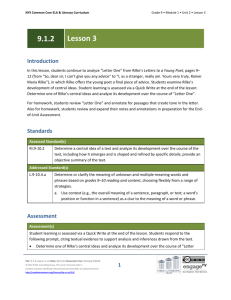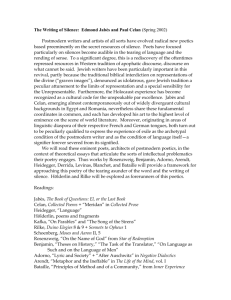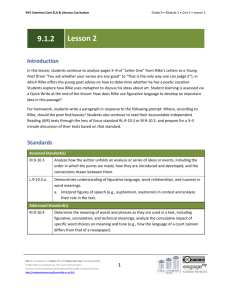Russia's Role in Metamorphosing Rilke's Poverty Concept
advertisement
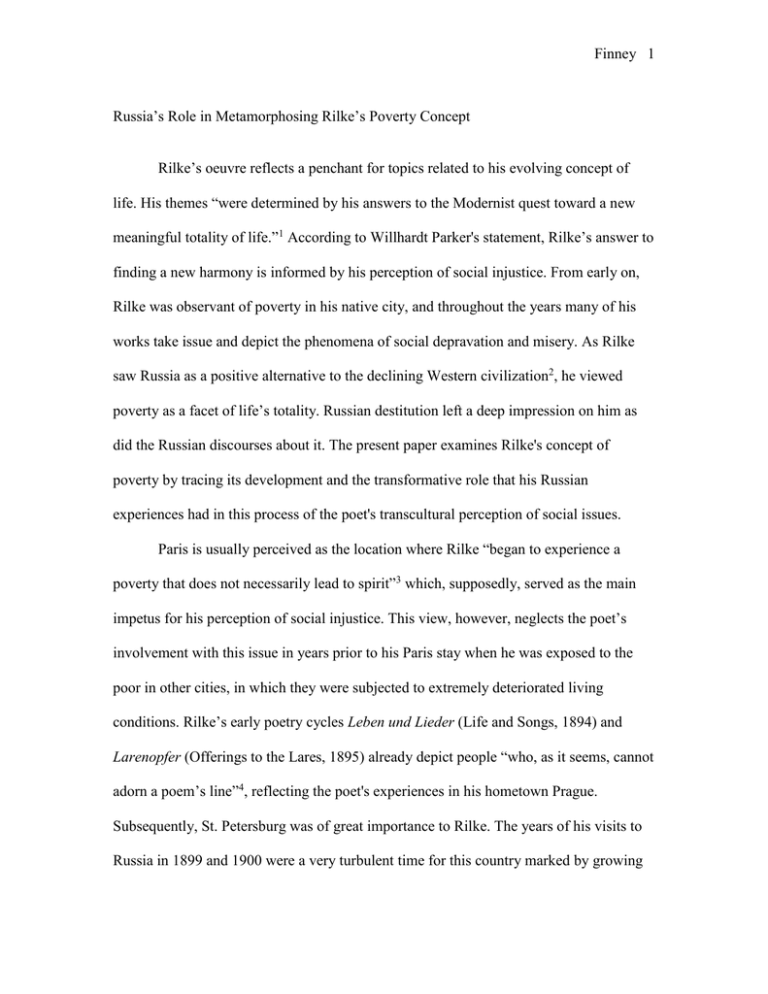
Finney 1 Russia’s Role in Metamorphosing Rilke’s Poverty Concept Rilke’s oeuvre reflects a penchant for topics related to his evolving concept of life. His themes “were determined by his answers to the Modernist quest toward a new meaningful totality of life.”1 According to Willhardt Parker's statement, Rilke’s answer to finding a new harmony is informed by his perception of social injustice. From early on, Rilke was observant of poverty in his native city, and throughout the years many of his works take issue and depict the phenomena of social depravation and misery. As Rilke saw Russia as a positive alternative to the declining Western civilization2, he viewed poverty as a facet of life’s totality. Russian destitution left a deep impression on him as did the Russian discourses about it. The present paper examines Rilke's concept of poverty by tracing its development and the transformative role that his Russian experiences had in this process of the poet's transcultural perception of social issues. Paris is usually perceived as the location where Rilke “began to experience a poverty that does not necessarily lead to spirit”3 which, supposedly, served as the main impetus for his perception of social injustice. This view, however, neglects the poet’s involvement with this issue in years prior to his Paris stay when he was exposed to the poor in other cities, in which they were subjected to extremely deteriorated living conditions. Rilke’s early poetry cycles Leben und Lieder (Life and Songs, 1894) and Larenopfer (Offerings to the Lares, 1895) already depict people “who, as it seems, cannot adorn a poem’s line”4, reflecting the poet's experiences in his hometown Prague. Subsequently, St. Petersburg was of great importance to Rilke. The years of his visits to Russia in 1899 and 1900 were a very turbulent time for this country marked by growing Finney 2 overpopulation with dire consequences for the lower classes. Rapid industrialization and urbanization caused substandard living conditions for the impoverished city dwellers. Land shortage, financial burdens on the peasants in the form of redemption debts and indirect taxation, coupled with primitive methods of cultivation, produced stagnation in agriculture and forced people to leave the villages and seek any form of work and usually inferior habitat in the industrializing cities5. In the years 1900-1904 alone, the unfavorable labor conditions provoked 1000 strikes which engaged 430,000 workers overall. As compared to the Western European industrial workers at the turn of the century, Russian laborers had the lowest wages, the longest work day (11-14 hours), and the most unfavorable living conditions6. Constant influx of people to Moscow and St. Petersburg produced a housing crisis forcing the less advantaged to live in factory dormitories, slums, and even small corners of rooms, often in basements. By 1900, about one-sixth of Moscow’s and St. Peterburg’s population lived in such corners7. The misery of the Russian villagers and the urban destitute in the big cities of Moscow and St. Petersburg did not go unnoticed by Rilke. In a letter to Sophia Schill from 29th of August 1900 he writes: “Don’t you believe, highly respected Sofija Nikolaewna, that I idealize the village life; I know well, there is a lot of sorrow and misery.”8 While the spiritual life of the Moscow-dwellers took precedence over other city facets in Rilke’s eyes, his experience of St. Petersburg left a myriad of disturbing impressions on the poet. In August 1900 he writes to Lou Andreas-Salome: “It was inexpressibly frightful to live these days […] with the most hostile impressions of this heavy city.”9 A few years later in 1908, Rilke wrote the poem Nächtliche Fahrt (Night Ride) comparing St. Petersburg to a mirage brought about by mental illness. Rilke’s Finney 3 Petersburg foreshadows Malte’s Paris, a metropolis that is enigmatic, exuding fear, and possessing an overpowering impact. Much of the literary criticism views Rilke’s portrayal of social injustice skeptically. Poverty depictions in Rilke’s early works are often disregarded as kitsch10, while his later Das Buch von der Armut und vom Tode (The Book of Poverty and Death, 1903) and Die Aufzeichnungen des Malte Laurids Brigge (The Notebooks of Malte Laurids Brigge, 1910) are read as an attempt at the aestheticization of poverty11. Prominent Russian researcher Ada Berezina disagrees with these critiques of Rilke’s early works emphasizing the importance of viewing individual poems as pieces of a larger cycle. Her holistic approach reveals a multifaceted image of poverty in Rilke's early poetic cycle Offerings to the Lares as her interpretations engage a variety of different perspectives. Two poverty poems, Im Dome (In the Cathedral) and Das arme Kind (The Poor Child), are reminiscent of naturalist writings: they offer a glimpse into the living conditions of two poor children explaining their psychological and spiritual numbness. The child in the poem In the Cathedral is completely detached from any messages the grand cathedral was to communicate by design: “Von den ganzen Glanze floß ihm / in die Brust kein Fünkchen Segen …” (Out of all the glamour / not even a single sparkle of the blessing flowed in his chest…)12. The word "blessing" reveals the futility of the message, as the child's poverty is incapacitating and prevents any participation in the splendid ritual. Thus, there is no chance to connect to God in prayer and no inner strength can be gained in the face of adversity. The girl in the poem The Poor Child likewise is deprived from achieving a sense of community and faith in a redeeming future. Finney 4 Following the images of these unfortunate children is the depiction of the city’s poor. The poem An der Ecke (At the Corner) portrays a self-sufficient, dedicated, robust, and known-by-all old Czech woman who takes pride in what she does: selling chestnuts at the corner. Her image starkly contrasts the sad, undernourished children: “Ihr Antlitz schaut aus einer Tücherspalte / Froh und gesund” (Her face is looking out of the scarf’s crevice / Glad and healthy)13. The devotion with which old Toni attends to her duties – roasting chestnuts, - is depicted as cheerful. According to Schoolfield, Rilke places a “naughty joke: she is married to her bow-legged stove, and sternly demands “heiße Pflicht“ (hot duty) from her husband.”14 The societal expectation of fulfilling marital duties is paralleled to Toni’s occupational responsibilities which force her into a subservient role in both realms. Deprived of agency, she nevertheless keeps smiling. In a not very subtle manner does Rilke critique women's roles in society and at work. A very different image is presented in the poem Hinter Smichov (Behind Smichov) which depicts a group of workers, broken and numbed by exhausting labor, as they are returning from work. This image highlights the exploitation of both genders rampant in the modern industrialized society. Harsh living conditions and back-breaking labor leave indelible marks on their faces revealing their loss of identity “auf ihre niedern, dumpfen Stirnen / schrieb sich mit Schweiß und Ruß die Not. / Die Mienen sind verstumpft; es brach/ das Auge […]” (on their low unfeeling foreheads / need signed itself with sweat and soot. / The faces are dulled; broken / are the eyes)15. The poem focuses on several parts of the body that show the dissociation and dehumanization of the people in this group portrait. This depiction is placed in Rilke’s poetic cycle next to the poem Freiheitsklänge (Sounds of Freedom), where Rilke pays tribute to the desire of the Finney 5 Czech people to be free while he simultaneously warns against violence16. Read in the context of the whole cycle, Behind Smichov warns of the potential for a social uprising and appeals for intervention on the part of the oppressed. Rilke’s early poetry reflects many aspects of poverty: poverty as social injustice, as everyday living condition, and as cause for potential violence. Common to the imagery in its diversity are the realistic tendencies that eschew mere aestheticization. Rilke revisits the theme of poverty a few years later in his poetic cycle The Book of Poverty and Death painting a strikingly different portrait of the poor. Here and in later poverty depictions, there is the tendency to be abstract which prompted an accusation of aestheticizing the disadvantaged. Egon Schwarz saw Rilke’s poverty depiction as a “combination of religious and aesthetic elements”, as a “phenomenon that has nothing to do with the social world, a phenomenon for which it makes no sense to search out causes and try to do away with them.”17 The demand to “search out causes” of poverty in the pursuit of social change imposes a notion of political advocacy and activism that collides with Rilke’s self-understanding as a poet. Jan Wojcik observes that for Rilke, “art is hardly moral or immoral.”18 In aspiring to depict poverty in its totality, as a disturbing facet of life, Rilke would not to limit his imagination by considerations of political correctness or social advocacy on behalf of the lower class. His poetics clearly are centered on grasping the disquieting realities of poverty in truthful images with compassion and sincerity. In contrast to Schwarz, Patrick Greaney's recent analysis focuses on the poet’s language, specifically the frequent use of simile in The Book of Poverty and Death, designed to question any aestheticization of the poor and, indeed, the very possibility of Finney 6 representing them at all.”19 The central figure of this work, the Poor One, is called upon to save the urban destitute from their impersonal deaths and meaningless way of living. Greaney states that Rilke underscores the inability to capture the essence of this being with language: the Poor One is “as if without a name”, meaning that he indeed possesses a name but that this name is not known or is beyond human comprehension. According to Greaney, the simile that describes Poor One’s attributes “assigns characteristics and, at the same time, emphasizes the estrangement from them with its ‘like’ that separates vehicle and tenor.”20 Notice Rilke’s similes concerning the poor: “wie Scherben fortgeworfen, wie Skelette, / wie ein Kalender, dessen Jahr verran...“ (thrown away as if they were shards, as skeletons,/ as a calendar, which year is expired...)21. Later in the poem, their fragile appearance is depicted in the subjunctive: “Betrachte sie und sieh, was ihnen gliche” (Gaze at them and see, what could compare to them)22. Contrary to the critics who see a glorification of poverty in Rilke’s description of the bodies of the poor, Greaney states that even the fleeting moments where the poor appear “so beautiful. . ./ so passionate und so wonderful” are contradicted via the “cycle’s foregrounding of its own inability to present the poor at all.”23 Greaney argues that Rilke’s poor, in spite of their estrangement, create a new form of community based not on a “shared identity or purpose” but on a “shared estrangement and exposure”.24 In Rilke’s Notebooks Malte, a young Danish aristocrat who is separated from his family, homeland and even his own name, is terrified by his encounters with the beggars in the city. His fear is evoked not by their unsightly appearance but by the recognition of such a community and his belonging to it. Finney 7 Greaney’s refutation of the notion of Rilke's aestheticization of poverty does not engage the poet’s aesthetics of empathy. However, Rilke’s poor are not mere incomprehensible objects difficult to represent. They are, above all, beings who can be empathized with. As Sabina Becker notes, Rilke’s Malte differs greatly from the historical city observer, the flaneur, who is engaged in “pleasurable-seeing and detached looking.”25 Originally theorized by Edgar Allen Poe and Charles Baudelaire, the classic city walker “can reap aesthetic meaning and an individual kind of existential security from the spectacle of the teaming crowds.”26 In The Painter of the Modern Life (1863) Baudelaire stated: “The crowd is his [flaneur’s] domain, just as the air is the bird’s, and water that of the fish.”27 In contrast to the flaneur who feels at home in the city, Malte lacks any confidence that would allow him to keep a distance from the overstimulation of the metropolis and the suffering of its inhabitants. He embraces every emotion and feeling evoked by the presence of urban destitution and experiences a strong desire to improve the condition of the suffering. Malte’s encounter with an epileptic reveals his complex attitudes towards the city poor. While he does not physically help the sick man, he silently follows the epileptic who collapses and is encircled by the crowd. At that point Malte invests all his mental energy to assist the epileptic who succumbs to intensifying seizures: “I pulled together my little bit of energy like money, and as I looked at his hands begged him to please take it if he needed it. I believe that he did take it; what could I do that it was not more.”28 Rilke’s Book of Poverty and Death, while containing the frequently debated statement that the poor should be allowed to be as poor as they truly are, shows the poet’s understanding of poverty as a case for empathy towards his fellow humans and the Finney 8 possibility of identifying with the other. But Rilke refuses to give the poor definite attributes, both individually or as a group. This perception of poverty as a lack of a clearly defined social identity harks back to the teachings of the medieval theologian Meister Eckhart, whom Rilke held in high regard29. Meister Eckhart makes a clear distinction between the “true poverty”, or poverty of spirit, and the lack of material possessions30. The poverty of spirit restores the Self to its original existence before it was shaped by God into a creature. Achieving this state requires repudiation of all knowledge, including self-perceptions, and all desires, including the wish to please and discover God. Eckhart encourages eliminating any connotations associated with any ideas about God from one’s mind since their presence only interferes with the Divine presence inside the Self. The human mind is too weak to even distantly grasp the greatness of God, and true blessedness can only be achieved by discarding all knowledge and by merging one’s identity with the eternal being. Eckhart’s poverty of spirit theorized as freedom from pre-conceived notions of God and the dissolution of identity allows for a new reading of Rilke’s Book of Poverty and Death. When Rilke calls for letting the poor be as poor as they really are, when he employs the simile in his poems to avoid the limitations of concrete images, he strives to eschew imposing any formula on these people who deserve to be recognized as individuals. Just as Eckhart’s believers are able to achieve unity with God by understanding the limitedness of societal constructions of the Divine, Rilke refrains from any classification of individuals based on their material income. Eckhart’s poverty definition was not an influence on Rilke in the strict sense, as the poet claimed to have been Eckhart’s disciple before becoming familiar with his Finney 9 works. Rilke’s Russian encounter which preceded this paradox occurred earlier and might have changed the poet’s poverty perceptions which, in effect, showed a strong affinity to Eckhart’s philosophy. Two aspects seem to have been decisive in the process of developing this kinship: Rilke’s experience of simple yet very powerful religiosity found in the Russian poor and his study of Russian literature and philosophy. Rilke’s participation in the Orthodox Easter festivities offered a new notion of the poor. In a letter to Jelena Woronona from July 27th 1899, Rilke writes: “In front of the small Иверская [Iverskaia] Chapel in Moscow: there, the kneeling are larger than those who stand, and those who bow, erect themselves tremendously.”31 As has been argued, Rilke borrowed the association of the Russian peasant with “deeply trusting simplicity and human passivity” from Lou Andreas-Salome and projected it onto the Russian pilgrims.32 Yet Rilke’s perceptions of the Russian peasants engaged in prayer are not limited to their presumed naïveté and passivity. In Rilke’s eyes, communication with God served simple Russian folk as a means to construct the sense of self as respectful, worthy members of society regardless of their social standing. The poet grasped the emphasis of the Russian Orthodox Church on equality before God. This implies both personal worthiness of each individual and personal responsibility to live in concord with Christian values. Rilke’s perception of the prayer as a meaningful, personal experience is supported by his essay on Russian art where he stresses the necessity of an active spiritual engagement of the believer for achieving the goal of the prayer, namely the elevation in “die reifen Wirklichkeiten seiner Seele” (mature reality of the soul)33. Even if the Orthodox icon serves as a gateway to God, it is just an empty space, where the looking person must re-create what the artist has previously created. Finney 10 To Rilke, who read and thought highly of several Russian works on social inequality and its consequences for an individual, the significance of Russian literature is two-fold. On the level of intertextuality, his works contain multiple references to the images of destitution created by Russian authors. For instance, in spite of choosing Paris as the setting of his Notebooks, Rilke frequently relies on the portrait of the poor he experienced in Russia. Patricia Brodsky notes that “much of the external form and a number of details in [Rilke’s] crucial crèmerie episode in The Notebooks come from Dostoevsky’s novel The Insulted and the Injured.”34 Protagonists in both works encounter an old, poor, and estranged from the community person in a cheap café whose impending death they manage to recognize. It produces the feeling of extreme discomfort in the protagonists and serves as a turning point in the texts. In their descriptions of these elderly poor, Dostoevsky and Rilke depict the lack of eyesight and vision as both physiological and symbolic for the diminished being and their imminent deaths. Other similarities include the fact that both protagonists have writing as their occupation (Ivan is a novelist, Malte is a poet), their poverty, their recent arrival and the feeling of isolation in a big city, and the time of year (spring). Another example is the Notebooks’ image of a poor female street organ player who is accompanied by her children in the task of begging. This scene of destitution was part of the St. Petersburg urban landscape prompting Dostoevsky to depict it in Crime and Punishment. Since Rilke believed that experiences must be lived and forgotten before they can be remembered and become useful to a poet35, such intertextual references indicate that Rilke's Russian experiences ceased to be mere memories during his Parisian time becoming integrated into his very perceptions and imagination. Finney 11 Dostoevsky’s first novel Poor Folk was most influential for Rilke’s Notebooks as their intertextual correspondences reveal. Of greater significance in this context are the obvious parallels between Dostoevsky and Rilke in their understanding of poverty. Rilke’s very positive reception of Dostoevsky’s Poor Folk is documented in his letter to Benois from the 28th of July, 1901 or his Schmargendorf diary where he states, “Ich weiß kein Buch, welches ich daneben nennen könnte” (I know no other book which I could place next to it)36. Clearly, Rilke saw in the work of his Russian counterpart a model and inspiration. Poor Folk holds a special place in Russian literature since, unlike other literary works at the time, it portrayed the destitute foremost as human beings worthy of respect and possessing their own voice37. Not unlike Rilke, Dostoevsky “derided [the] notion that subversion of political and social institutions was enough to ameliorate human existence: his profound conviction was that only inner spiritual and moral renewal would work.”38 The tragedy of Dostoevsky’s protagonist Devushkin in Poor Folk is not based solely on his poverty but in the fact that his identity is constructed by others. As Mikhail Bakhtin notes: “His consciousness about self is constantly perceived against the background of the other’s consciousness of him – ‘I for myself’ against the background of ‘I for another.’ Thus the hero’s words about himself are structured under the continuous influence of someone else’s words about him.”39 Destitution means not only the lack of the means of subsistence but it also causes a sense of insecurity as the poor continually fear the judgments and denigrations by others. Having walked around in clothes which revealed his destitute state, Devushkin concisely summarizes the attitudes and behavior towards the poor: “Yes, write about him as you like – let scribblers say what they choose Finney 12 about him: he will ever remain as he was. And why is this? It is because, from his very nature, the poor man has to wear his feelings on his sleeve, so that nothing about him is sacred.”40 Being labeled, Devushkin feels imposed upon, both intellectually and spiritually, to adhere to a set of preconceived ideas about the Petersburg poor. His plea to the contrary is reminiscent of Malte’s observation of constructed deaths the urban poor experience in Paris: “This excellent Hôtel is quite old, people were already dying in it in several beds in King Chlodwig’s time. Now there is dying in 559 beds. Factory-style, of course”41. In Rilke’s view death, one of the most personal events in human life, is labeled and classified by society, while people are turned into statistical facts. When life comes to an end in an “impersonal death”, it becomes questionable whether or not, it was aspired, deserved and achieved by the person who has perished. Rigid societal perceptions and expectations reduce the poor to statistical numbers and social class members with predictable behavioral and thought patterns. This image produces the sense of insecurity and negative self-perceptions depriving the poor of personhood and individuality. Consequently, the world assumes in their eyes the state of a meaningless realm that prevents any self-development. A remedy to this dilemma is the awareness, that a true self is hidden under multiple identity-masks, which are constructed by society, while achieving the redemptive “poverty of spirit” that Meister Eckhart extols. When both Malte and Devushkin are approaching this state, as described by the mystic, they experience a dissolution of human bonds and the dissipation of identity. They also engage in the act of writing. Rilke’s novel contains the idea of human liberation, which can be found in other works of Modernist Literature, such as André Breton’s Nadja, which has been described Finney 13 as “the peeling off of the rational layers from the human subject”. Here, the dissolution of a specific historical and social identity “forces the self to see what has always been veiled from him by his habitual attitude to life” including the construct of the self imposed by the society42. Malte’s progression to this type of liberation is inseparably linked to his exposure to the destitute and to writing. In Dostoevsky’s Poor Folk, the act of writing also serves as a means of developing a sense of self. While Devushkin never achieves the same level of complexity in his thinking as Malte, his progress from the state of being constantly constructed by others advances to the expression of personal feelings, which is truly remarkable. Writing letters allows him to “acquire a unique voice over the course of the narrative”43 and eventually to distance himself from the anxiety of being degraded. His final letter reads more like a journal entry since his friend Varvara leaves St. Petersburg having accepted an offer of marriage. Devushkin knows that she will most likely never read what he wrote. Having lost his only treasured personal bond, Devushkin’s writing is without any addressee or pragmatic purpose, evolving into a soliloquy revealing his new unassuming and fragile self. Dostoevsky’s idea that the tragedy of the poor lies in a constant influx of identities that are constructed by others might have very well led Rilke to abandon the creation of concrete images of poverty and to place greater emphasis on spirituality and personal integrity in his poems about the poor. In addition, Rilke’s experience in the Russian Orthodox Church of alternative ways of perceiving the poor undoubtedly left an indelible mark in the poet’s mind and imagination. Rilke’s journey from depicting external circumstances of the poor in negativity-laden images to the creation of less Finney 14 fixating forms of representation was, to a large degree, prompted by his Russian encounters and the opportunity to respond transculturally by fusing his poetic sensibility with cultural elements of this experience. Notes 1 Parker Willhardt 276 For a comprehensive discussion see Tavis, xiii 3 Bly 11 4 Berezina 29 5 Seton-Watson 109 6 Orlov 314 7 Moss 121 8 cited in Asadowski 190 9 cited in Brodsky 194 10 For instance, see Peter Demetz. Rilkes Prager Jahre. Düsseldorf : E. Diederich, 1953. 11 For instance, Homann, Rainer. "„Denn Armut ist ein Glanz aus Innen...“Armut und Kunst." Handbuch Armut und Soziale Ausgrenzung. VS Verlag für Sozialwissenschaften, 2008. 166-179. Print. Or Egon Schwarz. 12 Rilke Gedichte 12. Translation is mine. 13 Rilke Gedichte 30-31. Translation is mine. 14 Schoolfield 70 15 Rilke Gedichte 47 16 Schoolfield 71 17 Schwarz 65 18 Wojcik 571 19 Greaney 100 20 Greaney 102 21 Rilke Schriften 301. Translation is mine. 22 Rilke Schriften 304 23 Greaney 108 24 Greaney 124 25 Beicken 4 26 Tester 2 27 Cited in Tester 2 28 Rilke Notebooks 51 29 In a letter to Countess Luise Schwerin from the 5th of June, 1905, Rilke wrote: “Sie werden… eines Tages sehen, wie sehr ich, ohne von ihm zu wissen, schon seit Jahren dieses Meistes [Eckharts!] Schüler und Verkünder war. (You will . . .see one day how 2 Finney 15 much I, without knowing about him, already for years have been pupil and enunciator of this Master (Eckhart!). 30 For a comprehensive discussion see Eckhart 34-37 31 Cited in Asadowski 102 32 Mattenklott 26-27 33 Rilke Schriften 154 34 p. 157 35 For instance, in his Notebooks, Rilke writes: “But it is still not enough to have memories. One must be able to forget them, if they are many, and have the great patience to wait for them to come again […] Only when they become blood in us, glance and gesture, nameless and no longer to be distinguished from ourselves, only then can it happen that in a very rare hour the first word of a line arises in their midst and strides out of them” (12). 36 Cited in Schoolfield 109 37 Frank 78-79 38 Marks 67 39 qtd. in Souris 220 40 Dostoevsky 83 41 Rilke The Notebooks 5 42 Roll 229 43 Souris 229 Bibiography Asadowski, Konstantin. Rilke und Russland: Briefe, Erinnerungen, Gedichte. Berlin : Aufbau-Verlag, 1986. Print. Becker, Sabina. Urbanität und Moderne: Studien zur Grossstadtwahrnehmung in der deutschen Literatur, 1900-1930. Vol. 39. WJ Rohrig, 1993. Print. Beicken, Peter. “Kafka’s Mise-en-scène: Literary and Cinematic Imaginary.” Journal of the Kafka Society of America. 24 (1-2) (2000): 4-11. Print. Berezina, Ada G. Poezia i proza molodogo Rilke [Poetry and Prose of the Young Rilke]. Leningrad Univ Press, 1985. Print. Brodsky, Patricia Pollock. Russia in the Works of Rainer Maria Rilke. Detroit : Wayne State University, 1984. Print. Dostoevsky, Fyodor. Poor Folk & The Gambler. Trans. C. J. Hogarth. London: J. M. Dent & Sons, 1956. Print. Eckhart, Meister. Vom Wunder der Seele. Eine Auswahl aus den Traktaten und Predigten. eds. Schmid Noerr, Friedrich Alfred. Stuttgart: Reclam, 2002. Print. Finney 16 Greaney, Patrick. Untimely Beggar: Poverty and Power from Baudelaire to Benjamin. U of Minnesota Press, 2008. Print. Marks, Steven G. How Russia Shaped the Modern World. Princeton: Princeton Univ., 2003. Print. Mattenklott, Gert. “Der geistige Osten bei Rilke und Kassner.“ Blätter der RilkeGesellschaft 15 (1988): 21-33. Print. Moss, Walter. A History of Russia. London : Anthem, 2002-2005. Print. Orlov, Aleksandr S. Istoriia Rossii [History of Russia]. Moscow: Prospect, 2005. Print. Parker, Alan, and Mark Willhardt, eds. Who's Who in Twentieth Century World Poetry. Routledge, 2002. Print. Rilke, Rainer Maria. Die Gedichte. Insel Taschenbuch: Frankfurt am Main und Leipzig, 1998. Print. ---. Schriften. Ed. Horst Nalewski. Insel: Frankfurt am Main und Leipzig, 1996. Print. ---. The Notebooks of Malte Laurids Brigge. Trans. Burton Pike. Champaign/ London: Dakley Archive, 2009. Print. Roll, Serafima. "Writing and Modernism: Liquidation of the Self." The Turn of Century: Modernism and Modernity in Literature and the Arts. New York: de Gruyter, 1995. 22643. Print. Schoolfield, George C. Young Rilke and His Time. Rochester, N.Y. : Camden House, 2009. Print. Schwarz, Egon. Poetry and Politics in the Works of Rainer Maria Rilke. New York : F. Ungar, 1981. Print. Seton-Watson, Hugh. The Decline of Imperial Russia 1855-1914. New York: Frederick Paeger, 1952. Print. Souris, Stephen. “Living Double Intensity”: Dialogized Consciousness, the Question of Satire, and the Ethics of Representation in Dostoevsky’s Poor Folk.” Dostoevsky’s Polyphonic Talent. Ed. Joe E. Barnhart. Lanham: University Press of America, 2005. 219-236. Print. Tavis, Anna A. Rilke's Russia: a Cultural Encounter. Northwestern Univ Press, 1997. Print. Finney 17 Tester, Keith, ed. The Flâneur. Routledge, 1994. Print. Wojcik, Jan. "Emerson and Rilke: A Significant Influence?" MLN 91.3 (1976): 565-574. Print.
